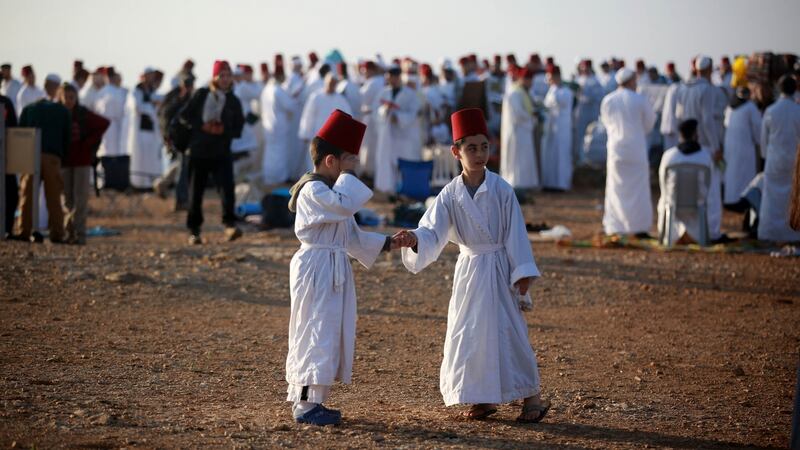The minibus worked its way up a winding narrow road, surrounded by rolling hills dotted with olive groves and vineyards, to one of the highest peaks in the West Bank – Mount Gerizim, revered by the Samaritans as the sacred site of their ancient temple.
The Samaritans are Israel's smallest religious community and the tiny sect – divided between Israel and the West Bank – continues to rely on the goodwill of both Israel and the Palestinian Authority for its survival.
Last week the Samaritans were celebrating the festival of Succoth, which was celebrated by Jews a month ago – the festival that commemorates the Biblical exodus of the children of Israel from Egypt.

Welcoming guests under a makeshift Succoth booth with a roof made from palm branches, citrus fruits, pomegranates and peppers, Husney Wasef Cohen, the brother of the high priest, noted that a National Geographic feature article back in 1919, when the total Samaritan population had declined to only 150 people, predicted the community was facing extinction.
“We have lived in this area continuously for more than 3,600 years and can trace our ancestry to 136 generations after Adam,” he said.
In Roman times the Samaritans numbered about a million but waves of conquest of the Holy Land, wars, persecution and forced conversion resulted in constantly shrinking numbers. In 1967, when Israeli forces occupied the West Bank in the Six-Day War, the community numbered 350.
Demographic challenge
Since then the situation has improved somewhat and the community has grown to some 840 members although the demographic challenge remains, creating pressure on children to marry within the religion.
The Samaritans trace their roots back to the original children of Israel who left Egypt with Moses and entered Canaan with Joshua.
Their holy books are written in an ancient form of Hebrew, a different alphabet from the Hebrew used by Jews, but their religious customs are derived from the Torah – the five books of Moses.
Children begin to learn the ancient language and study the Bible at age six but Arabic or Hebrew remains the language spoken at home.
Samaritan practice is very similar to Judaism and they observe the main Jewish holidays such as Yom Kippur, Passover, Succoth and Shavuot and strictly observe Saturdays as the Sabbath day of rest. However, they reject the Jewish oral law enshrined in the Talmud and do not consider Jerusalem a holy city.
Samaritans claim their worship is the true religion of the ancient Israelites prior to the Babylonian exile, preserved by those who remained in the land of Israel.
About half the community today live in a village close to Mount Gerizim in an area controlled by the Palestinian Authority. The families moved there from Nablus in 1988 during the first Palestinian intifada uprising, when the community was caught in the crossfire of the battles between Israeli troops and Palestinian militants.
The families speak Arabic and most continue to study and work in Nablus, the largest city in the West Bank. They carry Israeli and Palestinian ID cards as well as Jordanian travel documents in a unique arrangement for any West Bank community.
The rest of the Samaritans today live in the Israeli city of Holon, just outside of Tel Aviv. Those families speak Hebrew and serve in the Israeli army but are exempt from serving in the West Bank in another unique arrangement to avoid Palestinian resentment against the community.
‘Good situation’
Abdallah Wasef Cohen (85) was appointed high priest eight years ago. He conducts all the religious ceremonies, blesses the faithful and announces the start of holidays according to the Samaritan lunar calendar.
“Today we are in a good situation. We are living between Israel and the Palestinians and both are helping us and supporting us,” he said. “We pray for peace between Israel and the Palestinians.”
To maintain the community the children are encouraged to marry within the faith but the system of arranged marriages that was still common 20 years ago is no longer practised.
A shortage of available brides has led to a more flexible attitude towards conversions by the community elders over recent years. A priest will teach the basic tenets of the religion to females wishing to convert over a six-month period and will accept them as Samaritans if they show commitment to the faith.
The fact that the entire community is made up of four extended families has led to a number of cases of genetic disease due to the small gene pool and couples undergo genetic testing before being married.
High priest Cohen is not concerned about the future of the community. “I’m not worried the community will disappear. It’s written in the Bible that we won’t disappear. This is God’s will.”











